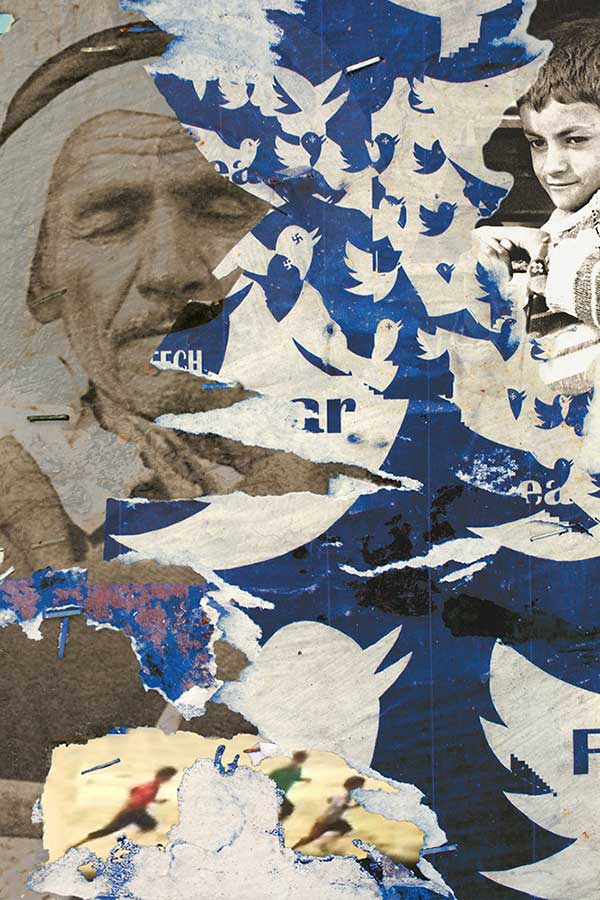‘The writing is on the wall’ is an indication of imminent danger. Its biblical origins come from a warning inscribed by a disembodied hand on the wall of King Belshazzar’s Babylonian palace. The words foretell the end of an unjust king’s reign, a vision of political change.
K Gallery’s exhibit ‘The writing is on the wall’ includes: Japanese calligraphy and carbon copies of typewritten letters from WWII internment camps, artist Najib Joe Hakim’s photographs of Palestinian and Lebanese walls and Salma Arastu’s paintings that are inspired by the scripture of the Quran.
Najib Joe Hakim returned to Lebanon in 2006 “…barely three months after the war destroyed much of the country…with millions of unexploded cluster bombs holding the future hostage.” Hakim transforms the devastation into poetic photographs of graffiti, text and torn political posters.
Salma Arastu brings Arabic calligraphy into dialogue with modern abstract painting. Born into the Hindu religion of India, she later converted to Islam. Salma’s life and work creates a bridge between culture, religion and art. Drawing on her Indian heritage and Islamic spirituality, she invites viewers to contemplate texts from the Quran, the poet Rumi, and for this exhibit she incorporates the words of activist Yuri Kochiyama, “Consciousness is Power, “ into her canvas.
The poetry and letters from the Japanese internment camps sheds light on how the Issei and Nissei, first and second generation Japanese immigrants to the United States, were able to endure incarceration during WWII. Their words express a quiet dignity and profound appreciation for life even in the face of adversity.
ART AND ARTISTS BIOS

Selections from a collection of poetry written in the WWII Heart Mountain-Wyoming internment camp, by a group of Issei, first generation Japanese immigrants, who called themselves the “Tachibana Ginsha.” The pieces show the calligraphers and visual artists working together to create a poetic image. The words and images portray a quiet dignity, and a profound insight for the beauty in life.
Tachibana Ginsha translates to “Standing Flower Poetry Group,” an apt description of a group of people surviving in the desolate lands of the relocation camps.
Image Translation:

May Okada was a fastidious record keeper, saving onion skin carbons of every typewritten letter she wrote. Her detailed observations and descriptions of daily life offer a window into an infamous time in history. In 1942, she had been married for 2 weeks before Executive Order 9066 sent Japanese Americans and their families to be incarcerated in WWII relocation camps as an act of national security.
The newlyweds were initially sent to Camp Walerga, a holding camp outside of Sacramento, then relocated to Tule Lake in the eastern Sierras. May’s letters from camp express a dry wit and appreciation for life that reveals an uplifting ability to endure the indignities and confinements of the camps both physically and spiritually.
Image: Dave and May Okada


Salma Arastu
Salma Arastu’s works are lyrical, spiritual, figurative, and calligraphic. Her paintings reveal stories of unity in diversity, peace and joy, celebration of life, and women and dancing whirling dervishes. Whether in paintings or sculptures, the faceless figures represent the universal oneness of all humanity. Her calligraphic work attempts to celebrate the same message of universality spread through verses in Arabic calligraphy and in the poetry of Rumi.
Arastu has had almost 40 solo shows nationally and internationally, and has won prestigious awards including the East Bay Community’s Fund for Artists in 2012 and 2014, the City of Berkeley’s Individual Artist Grant Award in 2014, 2015 and 2016. She has public art pieces on display in Bethlehem, Pennsylvania, and San Diego and San Raphael in California. She has also published five books.

Najib Joe Hakim
Najib Joe Hakim works as a documentary and editorial photographer. He is a Political Art Fellow at the Yerba Buena Center for the Arts and was also a nominee for the US Artist Fellowship.
Hakim’s current project, Palestine Diary, exhumes his 1978-79 B&W photographs in Palestine taken as a recent college graduate and combines the images with excerpts from his contemporary journal enlightening the roots of the crisis in Palestine today.
He received grants from the SF Arts Commission Cultural Equity Grant and the Arab Fund for Arts & Culture for his last project Home Away from Home: Little Palestine by the Bay – a multi-media storytelling exhibition juxtaposing recorded oral histories of 26 Bay Area Palestinian-Americans with their B&W portraits.
Hakim also produced a series of digital collages for The Map Is Not the Territory group project which explored the common historical experiences among the Palestinians, the Irish and Native Americans.
Press
Los Angeles Times, February 11, 2020. With canvas and Quran, one artist aims to make Islamic calligraphy a universal language. By Kimberly Winston.